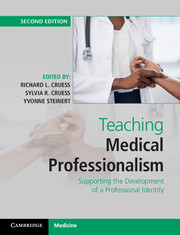Book contents
- Frontmatter
- Contents
- List of contributors
- Foreword
- Introduction
- Part I What is to be taught and learned
- Part II Theory
- Part III Principles
- Part IV Case studies in promoting professionalism and professional identity formation across the continuum
- 15 The evolution of an undergraduate medical program on professionalism and identity formation
- 16 Developing and implementing an undergraduate curriculum
- 17 Supporting professionalism and professional identity formation at the postgraduate level
- 18 Changing the educational environment to better support professionalism and professional identity formation
- Part V The future
- Index
- References
17 - Supporting professionalism and professional identity formation at the postgraduate level
from Part IV - Case studies in promoting professionalism and professional identity formation across the continuum
Published online by Cambridge University Press: 05 April 2016
- Frontmatter
- Contents
- List of contributors
- Foreword
- Introduction
- Part I What is to be taught and learned
- Part II Theory
- Part III Principles
- Part IV Case studies in promoting professionalism and professional identity formation across the continuum
- 15 The evolution of an undergraduate medical program on professionalism and identity formation
- 16 Developing and implementing an undergraduate curriculum
- 17 Supporting professionalism and professional identity formation at the postgraduate level
- 18 Changing the educational environment to better support professionalism and professional identity formation
- Part V The future
- Index
- References
Summary
It is during the … years that medical graduates spend as residents and clinical fellows that doctors come of professional age – acquiring the knowledge and skills of their specialties or subspecialties, forming professional identities, and developing habits, behaviors, attitudes, and values that last a professional lifetime.1 (p. 2)
Postgraduate medical education is a unique educational environment, with its emphasis on work-based learning, clinical supervision as a predominant method of training, performance-based assessment, and the challenge of simultaneously delivering education, training, and service.2 (p. 3)
Introduction
Learning how to be a professional is an essential part of residency – that period of time between end of medical school and unsupervised practice. Although professional socialization starts in medical school, professional values and behaviors are internalized and a physician's identity is formed to a great extent during residency. Despite this, there are few publications on teaching or assessing professionalism in residency or on how to influence the development of a professional identity at the postgraduate level. This chapter incorporates what has been learned at the undergraduate level and from the literature on identity formation to discuss the context, theory, and practice of how professionalism can be taught and assessed at the residency level. It also links learning, assessment, and institutional strategies to the development of a professional identity as a physician during residency education. The importance of producing professional physicians, and the central importance of residency education in this process, is underscored by both positive and negative examples. Papadakis et al.3 correlate poor performance on professionalism measures during postgraduate education with more disciplinary actions in practice. On the other hand, Wright4 underlines the importance of identifying and emulating positive role models, and their particular influence at the residency level. However, despite the calls for professional identity formation to be a foundational part of medical education during the residency years,5 “traditional residency education has not attended to shepherding new physicians through this process.”
Residency: the context
Compared to medical school, the largest part of learning during residency is work based, with an emphasis on education situated primarily in clinical settings: the workplace. As such, there are characteristics of this setting that have a strong influence on learning professionalism and fostering identity development.
- Type
- Chapter
- Information
- Teaching Medical ProfessionalismSupporting the Development of a Professional Identity, pp. 248 - 260Publisher: Cambridge University PressPrint publication year: 2016
References
- 1
- Cited by



